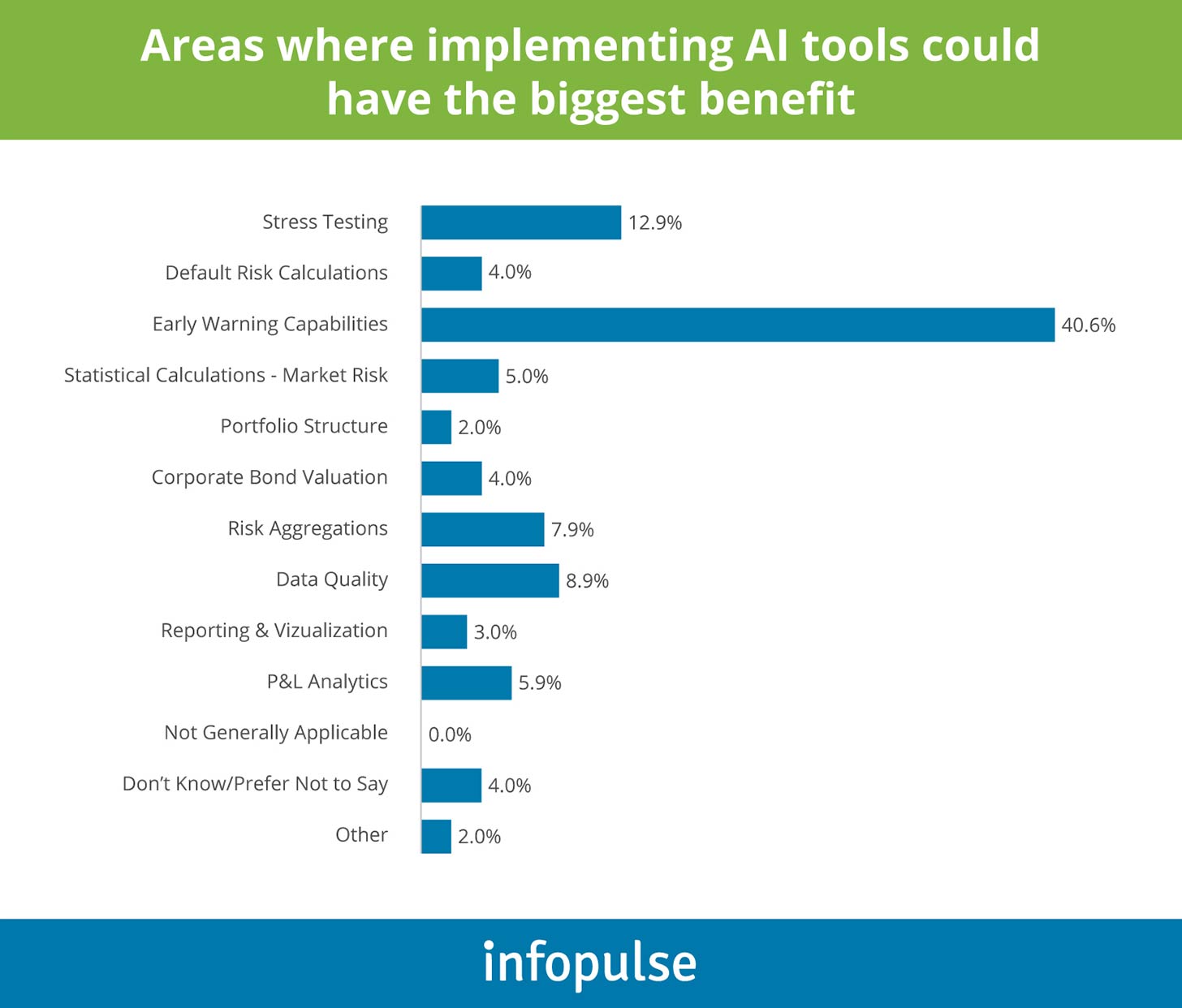Implementing AI for Financial Risk Management
While the digital economy grows stronger each year and new tech innovations emerge, the risks associated with private and commercial data are catching up as well. However, AI-powered technologies serve as an unrivaled tool for detecting and mitigating risks in today’s data-intensive environment.
Let’s take a closer look at the AI tools and solutions that can take financial risk management to the next level.
Mitigating Financial Risks with Intelligent Algorithms
Here is a quick statistical fact to get straight to the point of why AI is such a big deal for all industries: before 2012, Artificial Intelligence followed Moore’s Law by doubling its compute every two years; starting from 2013, compute has been doubling every 3 months (2019 Artificial Intelligence Index Report). The convergence of technologies and abundant data has revolutionized our approach to information and its usage, making it the most valuable asset and advancing the new era of data-based business models.
AI capabilities are embedded in solutions across all industries, optimizing processes, results, and profits across the whole value chain. Multiple domains, including financial services, telecom, and healthcare have to deal with immense volumes of personal and operational data, and, thus, capitalize on robotic process automation, computer vision, and machine learning technologies as core parts of their business processes (AI Index Report).
As for the BFSI industry, it’s one of the top adopters of AI for risk mitigation. AI can be used for trading, virtual assistants and chatbots, credit scoring, and market risk analysis. AI-powered technologies are widely utilized for personalized services, including debt management, investment, refinancing, and more (Grand View Research).
Essentially, AI is a great fit and a substantial upgrade for financial areas that rely on statistical methods. Broadly speaking, these intelligent algorithms are used to optimize the decision-making process related to loans and lending and prevent unwanted risks associated with financial wrongdoings and cybercrimes.
AI and ML-powered solutions redefine traditional credit scoring utilized by banks by analyzing hundreds to thousands of different variables (as opposed to dozens), including voluminous and complex digital footprint data. By providing such detailed and granular customer profiles, AI scoring techniques allow to approve more safe loans to applicants with no credit history and ensure the bank’s profitability.
Artificial Intelligence and Machine Learning are also integral tools for fraud and cybercrime prevention. Many banks turned to AML (anti-money laundering) systems to sift through data debris, including customer due diligence, sanctions screening, transaction monitoring, and other databases to predict suspicious actions. Machine learning algorithms are then able to determine customer behavior patterns and model the financial risks associated with such behavior.
It is clear that Artificial Intelligence, with its unparalleled ability to extract complex high-level abstractions and identify complex patterns from high-volume data, is a perfect tool for financial institutions operating in the regulated and competitive digital economy.
Risk Management Areas to Benefit the Most from AI
Poor cybersecurity continues to create major risks for companies across all industries. More and more sensitive data is being exposed, with cyberattacks on the rise. In 2019, financial services organizations spent 6-14% of their IT budget on cybersecurity (Deloitte).
Here are top 3 most important risk management areas that would benefit from AI adoption:
- Data quality is a risk management area that can greatly benefit from AI solutions targeted at AML and anti-fraudulent activities. Screening transactions and external risk factors aid in managing financial threat signals.
- Stress testing is another area that can boosted through the efficiency of AI and risk management solutions. It is focused on building complex simulation models with hypothetical scenarios to analyze the organization’s balance sheet resilience. The 2008 financial crisis is an example of an ill-managed portfolio risk driven by the lack of transparency and regulations.
- Early warning systems are also related to ‘what if’ situations, providing invaluable insights for bankers dealing with credit risk management. An AI-powered technology allows for the real-time processing and analysis of various internal and external factors regarding the financial, behavioral, geographic, industry, and perception indicators. Early warning systems are capable of capturing the slightest signs of stress that go unnoticed by human experts. For instance, a PoC of the early warning system enhanced with AI capabilities predicted default rates with higher accuracy, saving €11 million in potential bad loans.
Leveraging AI Techniques to See into the Future
Artificial Intelligence in all its forms is an excellent risk management tool that is praised for accurate data management capabilities. Immense amounts of unstructured data paired with strict compliance regulations is a driving force pushing financial organizations to leverage AI in risk and compliance. Even though it is impossible to measure AI maturity in the BFSI sector, intelligence technologies and solutions are utilized across broad implementation areas:
- AI and ML tools for credit and insurance risk measurement, behavioral analytics, customer segmentation, and market analysis
- RPA, data management, and regtech for governance and compliance purposes
- Big Data Analytics for financial fraud detection
For instance, one international bank in Hong Kong utilized AI for credit scoring, which resulted in reduced approval time from 10 to 2 days while raising the accuracy of credit analysis to 94%. On top of that, the AI-assisted underwriting sped up the client processing, enhanced user experience, and generated new revenue streams through analytical insights.
Even though the benefits of embedding AI in all business units and core processes are solid and tangible, the adoption of such an innovation-based strategy requires a clear vision, rigorous planning, and accurate implementation procedures. The key challenge stopping banks from embracing full potential of AI lies in their ill-structured data management ecosystem – plenty of valuable information that can be used for decision-making is still stored in paper documents.
Final Thoughts
Hopefully, the fast-paced advent of digitalization penetrating the financial industry eliminates the challenge of accessing valuable and quantifiable information. By digitizing and structuring complex data like benchmarks and credit curves, bankers can capitalize on highly efficient AI techniques of behavioral models and scenario generation in enterprise-wide risk management. Again, to leverage the multi-dimensional AI capabilities, industry leaders will need to adopt structural and mindset changes across the organization.
However, the best way to approach digital transformation of your business is by starting small. RPA solutions are the first step towards intelligent automation that allows you to optimize routine and time-consuming tasks and unburden the valuable human resources. By implementing fraud detection solutions, financial organizations can considerably decrease costs associated with cybercrimes and strengthen their cybersecurity. Sometimes, the best option to start with might be Big Data analytics that can measure the effectiveness of existing data management solutions, its sources, and their quality.
If you are looking for a trusted IT partner to implement or customize any of those solutions or to get an expert consultation on how to kickstart your digital transformation journey – contact us today to prepare your business for tomorrow!




![CX with Virtual Assistants in Telecom [thumbnail]](/uploads/media/280x222-how-to-improve-cx-in-telecom-with-virtual-assistants.webp)
![Generative AI and Power BI [thumbnail]](/uploads/media/thumbnail-280x222-generative-AI-and-Power-BI-a-powerful.webp)
![AI for Risk Assessment in Insurance [thumbnail]](/uploads/media/aI-enabled-risk-assessment_280x222.webp)
![Super Apps Review [thumbnail]](/uploads/media/thumbnail-280x222-introducing-Super-App-a-Better-Approach-to-All-in-One-Experience.webp)
![IoT Energy Management Solutions [thumbnail]](/uploads/media/thumbnail-280x222-iot-energy-management-benefits-use-сases-and-сhallenges.webp)
![5G Network Holes [Thumbnail]](/uploads/media/280x222-how-to-detect-and-predict-5g-network-coverage-holes.webp)

![How to Reduce Churn in Telecom [thumbnail]](/uploads/media/thumbnail-280x222-how-to-reduce-churn-in-telecom-6-practical-strategies-for-telco-managers.webp)
![Automated Machine Data Collection for Manufacturing [Thumbnail]](/uploads/media/thumbnail-280x222-how-to-set-up-automated-machine-data-collection-for-manufacturing.webp)
![Money20/20 Key Points [thumbnail]](/uploads/media/thumbnail-280x222-humanizing-the-fintech-industry-money-20-20-takeaways.webp)